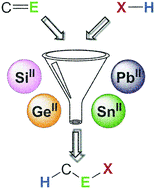当前位置:
X-MOL 学术
›
Chem. Soc. Rev.
›
论文详情
Our official English website, www.x-mol.net, welcomes your
feedback! (Note: you will need to create a separate account there.)
Low-valent group 14 element hydride chemistry: towards catalysis
Chemical Society Reviews ( IF 40.4 ) Pub Date : 2018-04-18 00:00:00 , DOI: 10.1039/c7cs00649g Terrance J. Hadlington 1, 2, 3 , Matthias Driess 1, 2, 3 , Cameron Jones 4, 5, 6
Chemical Society Reviews ( IF 40.4 ) Pub Date : 2018-04-18 00:00:00 , DOI: 10.1039/c7cs00649g Terrance J. Hadlington 1, 2, 3 , Matthias Driess 1, 2, 3 , Cameron Jones 4, 5, 6
Affiliation

|
The chemistry of group 14 element(II) hydride complexes has rapidly expanded since the first stable example of such a compound was reported in 2000. Since that time it has become apparent that these systems display remarkable reactivity patterns, in some cases mimicking those of late transition-metal (TM) hydride compounds. This is especially so for the hydroelementation of unsaturated organic substrates. Recently, this aspect of their reactivity has been extended to the use of group 14 element(II) hydrides as efficient, “TM-like” catalysts in organic synthesis. This review will detail how the chemistry of these hydride compounds has advanced since their early development. Throughout, there is a focus on the importance of ligand effects in these systems, and how ligand design can greatly modify a coordinated complex's electronic structure, reactivity, and catalytic efficiency.
中文翻译:

低价14族元素氢化物化学:朝着催化的方向发展
自2000年报道第一个稳定的化合物实例以来,第14组元素(II)氢化物络合物的化学性质迅速扩展。自那时以来,这些系统显示出显着的反应性模式,在某些情况下可模仿后来的反应模式,这一点已变得显而易见。过渡金属(TM)氢化物。对于不饱和有机底物的加氢精制尤其如此。最近,它们反应性的这一方面已扩展到使用第14组元素(II氢化物作为有机合成中有效的“类TM”催化剂。这篇评论将详细介绍这些氢化物化合物自其早期开发以来如何在化学方面取得进展。贯穿整个过程,重点关注配体效应在这些系统中的重要性,以及配体设计如何能够极大地改变配位配合物的电子结构,反应性和催化效率。
更新日期:2018-04-18
中文翻译:

低价14族元素氢化物化学:朝着催化的方向发展
自2000年报道第一个稳定的化合物实例以来,第14组元素(II)氢化物络合物的化学性质迅速扩展。自那时以来,这些系统显示出显着的反应性模式,在某些情况下可模仿后来的反应模式,这一点已变得显而易见。过渡金属(TM)氢化物。对于不饱和有机底物的加氢精制尤其如此。最近,它们反应性的这一方面已扩展到使用第14组元素(II氢化物作为有机合成中有效的“类TM”催化剂。这篇评论将详细介绍这些氢化物化合物自其早期开发以来如何在化学方面取得进展。贯穿整个过程,重点关注配体效应在这些系统中的重要性,以及配体设计如何能够极大地改变配位配合物的电子结构,反应性和催化效率。











































 京公网安备 11010802027423号
京公网安备 11010802027423号